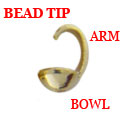 Knowing how to knot between beads is foundational for gemstone protection and to prevent loss. It is also an important skill that enables the professional pearl and bead stringer to extend his or her design and manufacturing capabilities. Knowing how to knot pearls and gemstone, for example, enables the pearl and bead stringer to create strong multi-strand necklaces in a variety of different designs as well as take advantage of the plethora of colored thread available.
Knowing how to knot between beads is foundational for gemstone protection and to prevent loss. It is also an important skill that enables the professional pearl and bead stringer to extend his or her design and manufacturing capabilities. Knowing how to knot pearls and gemstone, for example, enables the pearl and bead stringer to create strong multi-strand necklaces in a variety of different designs as well as take advantage of the plethora of colored thread available.
Just as important as knowing how to knot between beads is knowing how to use knots to secure the necklace to the clasp.
The process of securing a necklace to a clasp using knots involves taking the needle up through the last few beads, through the jump ring on the clasp and then back through those unknotted beads, however, during this second pass through, the beads are knotted.
The result is a piece of jewelry where all the elements are equally secure.
Unfortunately, pearl and bead stringers are often taught they can avoid this step, which does take practice to master, by using bead tips.
These are small findings whose appearance is somewhat like a bowl with an arm extending over it. The bowl has a hole drilled through its center. The bead stringer ties a knot larger than the hole and takes the needle through the hole and adds gemstones. The thin metal arm is then bent around the jump ring on the clasp it. This affixes the necklace to the clasp.
Knowing how to use bead tips, like crimping, is an essential skill. However, they, too, have their limitations. The thin metal arm can pull open, detaching the necklace from the clasp. This occurs when the owner pulls the clasp or when the beads are too heavy for the bead tip to support over time. And, remember that excessive manipulation of the metal can cause it to become brittle and break. (Excessive manipulation can occur if a less than skillful manufacturer opens and closes the bead tip repeatedly during manufacture and it also occurs when the bead tip pulls open and the owner or manufacturer pushes it back into place.) Bead tips used on bracelets, which often receive more wear and tear than necklaces, are often susceptible to this kind of breakage. A second type of breakage can occur if the knot pulls through the bowl of the bead tip.
So, in determining whether and when to use bead tips, the pearl and bead stringer must ask the questions: How heavy are the gemstones and will the bead tip support the gemstones over time? If you are designing the jewelry for a client, think about whether that client is rough on jewelry, that is, whether she is likely to pull at the clasp.
A final consideration is purely subjective. Bead tips are a mechanical element used to affix the necklace to the clasp. They are not decorative. This is not an issue when small, unobtrusive bead tips are used. However, I’ve seen multi-strand necklaces where multiple bead tips are used at the clasp. To my eye, these mechanical elements used in this way conflict with the design and diminish the overall appeal of the jewelry.
In all cases, manufacturing decisions must be made with the objective of delivering the strongest possible piece of jewelry to a client. When manufacturing strength is sacrificed for design or sometimes for silk’s protective properties, the decision to make that sacrifice should be informed and discussed with the client. No manufacturing decision should be made on the basis of the available skills of the pearl and bead stringer. He or she should have the foundational skills of knowing how to knot pearls and gemstones and attaching a necklace to a clasp with thread..

